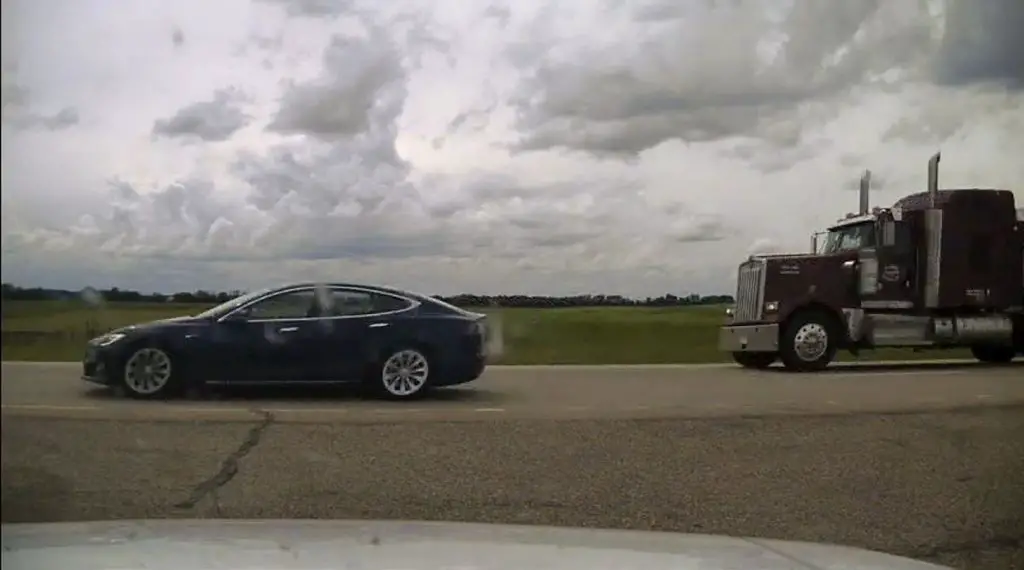In a bizarre incident occurring in Canada on September 17th, a Tesla Model S driver was caught sleeping while his car was running at high speed using the Autopilot mode. The police officer caught the car speeding, and a complaint came in, which suggested that the vehicle was not ‘in human control’ and the front row seats were completely reclined. This incident was reported near the town of Pokona, Alberta, Canada. The driver was charged with speeding and dangerous driving. Funnily enough, this isn’t the first time a Tesla driver was caught sleeping while the car was being driven on Autopilot mode, and it sheds light over the use of this driver assist feature by Tesla.

Tesla Driver Caught “Asleep” With Autopilot At 150 km/hr, Police Are Charging Him Criminally
Tesla Autopilot
Technology has taken over the automobile industry, and many companies are bringing AI (artificial intelligence) into their vehicles, integrating it into the infotainment system, driver-assist features, and whatnot. Tesla has been one of the major contributors to this transition, and their use of OTA (over-the-air) updates has been lauded by many experts. Through these updates, Tesla has managed to keep all their recently-sold vehicles up to date with the new technology that they are developing, like performance boosts, and particularly, the driver-assist features.
The California-based company has a number of driver-assist features running in their cars, out of which the most integral is the Autopilot system. Tesla has installed this feature in all their models, with an eye on the future of autonomous driving. The Autopilot system is capable of reaching a level of full self-driving capability, with a number of sensors such as cameras, ultrasonic, and radar constantly capturing data from the street across a 360-degree view.
With features such as Navigate (gliding across slow-moving traffic), Autosteer+ (navigating along tighter and more complex roads), and Smart Summon (drives the car out of the garage towards the driveway), they have built a robust driver-assist system. The Autopilot also has the self-driving capability, but Tesla has clearly mentioned that the driver should have their hands on the steering wheel and eyes on the road at all times to take control of the car at the appropriate time. Despite this, many drivers tend to ignore this and continue to consider the Autopilot as a fully autonomous driving program, taking the technology for granted.
Tesla’s Remedy
Tesla made it clear that having their vehicles on Autopilot mode does not allow the drivers to stop paying attention on the road. With many drivers not complying with this, they brought in the ‘Autopilot Nag’ update, which includes a pressure sensor placed inside the steering wheel, which will be able to detect whether or not the driver has his hands on the steering wheel, and if not, it will alert the driver about the same. There were many hacks for this update, as an ‘Autopilot Buddy’ was brought in by retail vendors, which acted as dead weight on the steering wheel, activating the sensor without the driver having to put his hands on the wheel. This ‘Buddy’ was shut down by the National Highway Traffic Safety Administration (NHTSA), but that did not stop them. The product was reintroduced into the market, this time as a mobile holder, trying to get a way around the Autopilot Nag.
Reactions to the latest incident
The Autopilot is a suite of driver-assist features and not an autonomous driving program. It has a level 2 self-driving capability, which, according to the regulations, requires the driver to have their complete focus on the road, ready to take control of the vehicle in case something goes wrong. Due to the fact that there have been not many incidents of self-driving systems failing in Teslas recently, the drivers have been less cautious, and more trusting in Tesla’s technology. In this case, the Canadian police reported strange behavior from the vehicle:
Alberta RCMP received a complaint of a car speeding on Hwy 2 near #Ponoka. The car appeared to be self-driving, travelling over 140 km/h with both front seats completely reclined & occupants appeared to be asleep. The driver received a Dangerous Driving charge & summons for court pic.twitter.com/tr0RohJDH1
— RCMP Alberta (@RCMPAlberta) September 17, 2020
“After the responding Officer activated emergency lights on their vehicle, the Tesla automatically began to accelerate. The Officer was able to obtain radar readings on the vehicle, confirming that it had automatically accelerated up to exactly 150 km/h.”
150 kmph is the maximum speed at which you can drive your Tesla in the Autopilot mode. The Tesla technology is more than capable of navigating through traffic, even at that high a speed, without any human intervention. But that does not mean you should do so. It might have been a case where the driver set the vehicle at that speed, and due to a leading car moving away, the Tesla accelerated up to its maximum capability on its own. The police report suggests that during this accelerating period, the front row seats were reclined fully, making it seem like the driver was sleeping. Driving at a speed that high, not only without hands on the wheel but also with your seat fully reclined, is most definitely a case of dangerous driving, especially when your automaker specifically advises you not to do so. It seems like the charges made on the driver are absolutely justified.


















